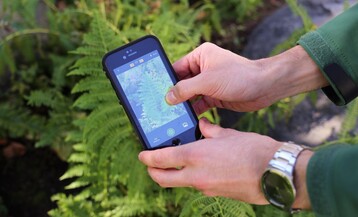Current Nature: Winter Exploration On Nantucket
Kristin Bullett •

We’ve had quite a warm spell, and Quentin the Quahog may have squirted in favor of an early spring, but there’s a month of winter left before the vernal equinox. There’s still plenty of time to catch the beauty of winter on island, especially with school vacation on the way!
It’s natural to want to curl up like a bear and hibernate all winter. It’s cold, it gets dark early, and there’s nothing to see, right? Well, have a little faith - you can keep warm, we’re getting more light every day and there’s so many natural wonders to get excited about.
Winter is an opportunity to see Nantucket’s nature in unique ways. Leafless trees open up viewsheds, allowing a different look across the landscape. Fewer visitors mean open trails and quiet spaces, where you can hear birdsongs or trickling water. You can explore wet, swampy places without pesky mosquitoes and flies. Winter here is hardly grey; soft winter sunshine gracefully accentuates the golden browns, deep reds, and rich greens across Nantucket’s landscapes.
We’re fortunate to have miles and miles of trails on Nantucket, but if you’re looking for a little something to do while you are out exploring, we’ve got a few ideas.
Geocaching: A modern-age digital treasure hunt!
Geocaching is a game of outdoor hide and seek with containers or other items that are hidden in public spaces for people to find. Most “caches” are a small weatherproof box containing a notebook and pencil to record your name and celebrate your find. There are often trinkets like matchbox cars, figurines, or stickers to claim as a prize for your hard work, supplied in a take-it-or-leave-it like fashion. Geocaching is a fun way to test your orientation and problem-solving skills while making discoveries. To find clues to cache locations on Nantucket, head to Geocaching’s website or download their free app to get your treasure hunt started!

Shed Hunting: This ain’t another reality HGTV show...
The sheds you’re “hunting” for are deer antlers that have been shed, or dropped. Male deer (bucks) grow their antlers in a cycle every year. Antler growth starts in the spring and continues through summer, when antlers will be “in velvet”, covered in a thin membrane of blood vessels to feed nutrients and minerals to the antlers to keep them growing. When antlers reach full size in fall, bucks rub them on trees to remove the velvet and polish them just in time for mating season. In early winter, the connection between the antler and the buck’s skull weakens until the antler drops off. Now is a good time to scour the ground for antlers. They’re pretty well disguised amongst the leaves and grass, but if you keep your eyes peeled you may come across a beautiful souvenir to remember your winter adventures!
Citizen Science: Getting outside with an impact
At its core, science is all about asking questions, making observations and experimenting in the world around us. You don’t need expensive equipment or a fancy degree to be a scientist. You can get involved with Citizen Science projects to put your particular skills and interests to use to collect data, record observations, and contribute information to a larger body of knowledge about a topic. One tool for Citizen Science is a free website and app called iNaturalist, where you can log observations you make in nature. When you’re out and about, snap photos of plants, insects, shells or anything you see in nature and upload them to iNaturalist. The app helps you identify what you’ve seen with a community of nature buffs around the world. You can also help others identify their observations! Another great perk of iNaturalist is the digital journal it creates, so you have records that are fun to look back on and review. Researchers use data in iNaturalist to monitor trends and changes in where species can be found, so it’s a fun way to get involved locally with a large-scale impact!

Learning to love being outdoors in winter is an adventure in itself, so take it slow. Visiting places you know well and keeping it short and sweet is a great way to start. One of my favorite sayings is “quit while it’s still fun”, which makes you want to go back for more and keeps a positive outlook about the activity. Being prepared keeps you safe and sets you up for an enjoyable time- extra layers of warm clothing and information on where you’re headed can prevent the misery of cold toes or being out for longer than you planned. Snacks and water are key items to bring on any outdoor adventure. Both are essential to keep your energy up and your body warm. Ticks are present year-round so it’s important to stay on trails and check yourself thoroughly after spending time outdoors.
New to winter exploration? Nantucket conservation organizations have teamed up to provide free nature programming to the community over the next few months. Trying something new with a group can be a great way to build confidence and comfort, and we’d love to see new faces! Check out the details here.
Wishing all a safe and adventure-filled winter!
Stay tuned for more editions of Current Nature, a bi-weekly column featuring seasonal topics, natural history information, and advice on the outdoors from the staff at the Linda Loring Nature Foundation.
